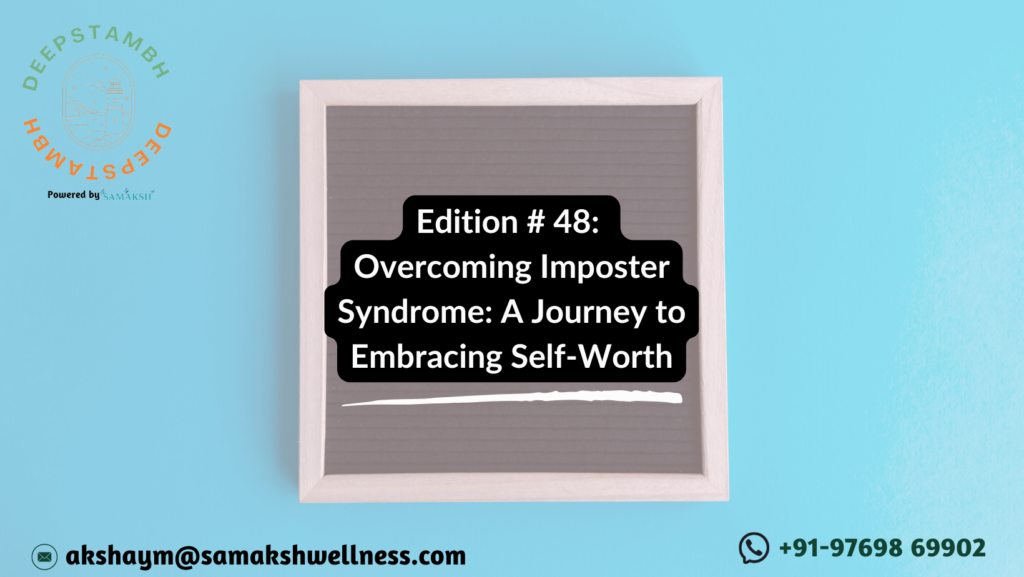Overcoming Imposter Syndrome: A Journey to Embracing Self-Worth

In today’s fast-paced corporate world, many business leaders—despite their remarkable achievements—struggle with feelings of inadequacy and self-doubt. This crippling experience is known as Imposter Syndrome, a psychological phenomenon where individuals doubt their skills and accomplishments, feeling like a fraud even when they’ve proven themselves time and time again.
Take the story of Raghav (name changed for privacy), a Vice President of Sales at a leading pharma company. Raghav had built a stellar career over the years, driving impressive sales numbers, mentoring a strong team, and receiving numerous accolades for his leadership. Yet, as he rose in rank, so did his fear of being judged. He began questioning whether he truly deserved his success or if his achievements were just a stroke of luck.
The Struggles of Imposter Syndrome
Raghav often felt like he was wearing a mask—a façade of competence, while inside, he constantly feared that someone would find out he wasn’t as capable as he appeared. Despite leading a large sales team and being the go-to person for major business decisions, he found himself battling crippling anxiety every time he had to present in front of his colleagues or pitch to clients.
At the heart of Raghav’s struggles was a deep-rooted fear of being judged. No matter how many times he successfully closed deals or received praise, he couldn’t shake off the feeling that someone, someday, would realize he wasn’t good enough. This relentless self-doubt began to erode his confidence, affecting not just his performance but also his mental and emotional well-being.
The Turning Point
Raghav finally realized that he couldn’t continue this way. His performance, although still top-notch to others, was beginning to feel like a heavy burden. He was burning out, and it became clear that something needed to change. This was when he joined my SWAYAM: From Chaos to Clarity program, seeking a way to break free from his self-imposed limitations and improve his self-worth.
Steps Taken to Embrace Self-Worth
During the sessions, Raghav and I worked closely on a series of strategies designed to tackle his imposter syndrome head-on. Here are the key steps we implemented:
- Acknowledge the Fear The first step was simple yet profound: Raghav needed to acknowledge his imposter syndrome. Instead of brushing it aside or masking his fears, we encouraged him to face his self-doubt and recognize it as part of the human experience. By accepting it, Raghav stopped fighting an internal battle and began focusing on overcoming the root of his fears.
- Reframe Negative Self-Talk Imposter syndrome often comes with a harsh inner critic that amplifies every perceived shortcoming. Together, we worked on reframing Raghav’s negative self-talk. Every time his mind spiraled into thoughts like, “I’m not good enough” or “I don’t deserve this success,” he learned to counter it with affirmations like, “I am here because I have the skills and experience to lead” or “I’ve earned my place and my achievements are proof.”
- Focus on Achievements, Not Perfection Imposter syndrome often leads individuals to fixate on their flaws rather than celebrate their wins. We shifted Raghav’s focus from perfectionism to his track record of success. By reviewing his past achievements and the impact he had made on his company’s growth, Raghav slowly started trusting his abilities. It became clear that his success was not a matter of chance, but a result of his hard work and leadership skills.
- Adopt a Winning Mindset Raghav also embraced the idea of a winning mindset—the belief that skills and intelligence can be developed over time. This was crucial in helping him stop viewing every challenge as a potential failure. Instead, he began seeing setbacks as learning opportunities. By reframing his mindset, he gave himself the space to grow without feeling like every mistake was a reflection of his worth.
- Awareness & Acceptance Finally, Raghav learned the value of becoming aware every time he had self-doubt. He took time to reflect on his achievements, recognizing his fears but also accepting himself for who he was. Instead of running from the feeling of inadequacy, Raghav chose to embrace it. He also began to open up to his peers and seniors about his struggles, and in doing so, realized that many of them had experienced similar feelings of self-doubt. This awareness and acceptance helped him feel less isolated and more empowered to confront his imposter syndrome.
The Results: Confidence and Clarity
Over time, Raghav began to trust his abilities more. He stopped second-guessing every decision and, most importantly, let go of the fear of being judged. With his newfound confidence, he made bolder business decisions, stepped into leadership roles with greater ease, and rediscovered his passion for his work. By embracing his self-worth, Raghav was no longer paralyzed by imposter syndrome.
Imposter syndrome affects countless leaders, professionals, and entrepreneurs, often preventing them from realizing their true potential. But by working on your self-worth and adopting a winning mindset, you too can overcome this challenge and lead with confidence.
If you’re ready to let go of self-doubt and start embracing your self-worth, follow me on LinkedIn and join my next Mindset Bootcamp in October 2024. Together, we’ll create strategies that help you unlock your potential, overcome imposter syndrome, and live a life of clarity and confidence.

Add Comment